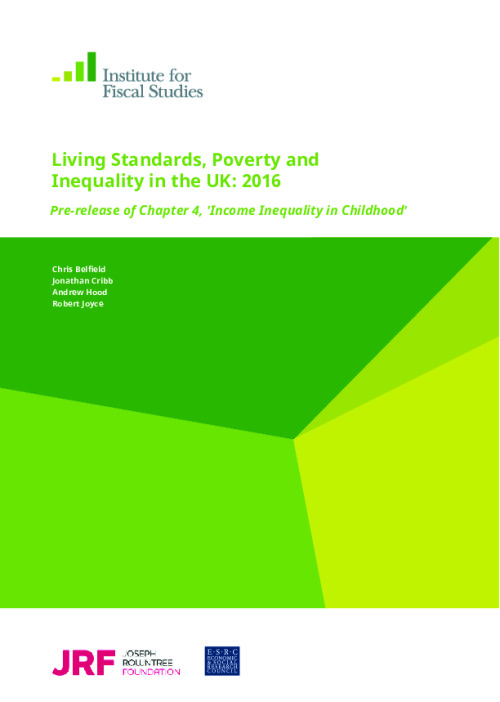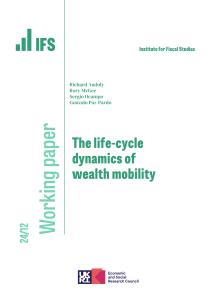How have household incomes evolved since the onset of the financial crisis? How has the gap between rich and poor changed? How have living standards changed over time for different parts of the population? How many people are in poverty and which groups are most likely to face poverty?
Each year, the government produces statistics about the distribution of income in the UK (‘Households Below Average Incomes’ or HBAI), which help answer these questions and many more. This report, funded by the Joseph Rowntree Foundation, is the fifteenth in an annual series published by the Institute for Fiscal Studies (IFS). It analyses the HBAI statistics and digs deeper to explore the driving forces behind key trends in living standards, inequality and poverty.
Our analysis of the latest HBAI data begins in Chapter 2 with a look at average living standards and how they have changed over time. Chapter 3 analyses how changes in incomes have differed across the income distribution, focusing in particular on the factors affecting inequality during the recent recovery in living standards. Chapter 4 examines in more detail how income inequality in childhood has changed over the last 20 years. Finally, Chapter 5 analyses changes in income poverty and in measures of deprivation that are not based on income. It also examines the role falling worklessness has played in reducing child poverty and discusses the relationship between incomes and measures of financial difficulties.
Chapter 4, 'Income Equality in Childhood' has been pre-released and can be downloaded below.
The full report will be launched on 19 July 2016. You can sign up for the event here.
| Key findings of Chapter 4 | |
| Household (BHC) income inequality among children has fallen since the mid 1990s. | This was driven by falls in inequality between the middle and the bottom of the distribution. In 1994–95, the child at the median had a household income 80% higher than the child at the 10th percentile. By 2014–15, this had fallen to 70%. Most of this fall in inequality has occurred since the recession. |
| Household income inequality is much lower among children than among working-age adults without dependent children. | This is mainly due to the benefit and tax credit system supporting the incomes of low-income households with children. |
| An important reason for falling child inequality has been a remarkable fall in the share of children living in a workless household. | In 1994–95, 60% of the poorest fifth (‘quintile’) of children lived in a workless household. This fell to 47% by 2007–08 and 37% by 2014–15. These falls in household worklessness contributed significantly to the growth in incomes in the poorest two quintiles of the child income distribution and had no effect on other quintiles. |
| The fall in the 50:10 income ratio for children since 1994–95 is not explained by changes in benefit incomes. | This is despite large increases in entitlements. A key reason is that rising employment rates for poor parents acted to reduce their benefit entitlements. However, changes in benefit incomes have prevented an increase in inequality between middle-income and high-income children since 1994–95. |
| The proportions of income from different sources for richer and poorer children have changed substantially in the last two decades. | For the poorest fifth of children, the proportion of net income coming from employment is now 42%, up from 33% in 2007–08 and from 27% in 1994–95.The proportion coming from benefits has fallen from 73% to 61% over the 20 years. In contrast, middle-income children now get 30% of household income from benefits, compared with 22% in 1994–95, while the proportion coming from employment has fallen from 77% to 70%. |
| There has been a big reduction in the disparity in income earned by men and women in households with children. | This has occurred right across the distribution. For example, in 1994–95, 19% of household income for middle-income children came from women’s employment and 58% from men’s employment. By 2014– 15, the proportion from women had risen to 26% and the share from men had fallen to 43%. |
| Children in lower- and middle-income households are now much more likely to live in private rented accommodation than was the case 20 years ago. | For the middle fifth of children, this was accompanied by a big fall, from 69% to 50%, in the proportion living in an owner-occupied house. For the poorest fifth of children, there was a big fall in the proportion in social housing (from 50% to 37% over 20 years). |











